
Granville County is a county located on the northern border of the U.S. state of North Carolina. As of the 2020 census, the population was 60,992. Its county seat is Oxford. The county has access to Kerr Lake and Falls Lake and is part of the Roanoke, Tar and Neuse River watersheds.
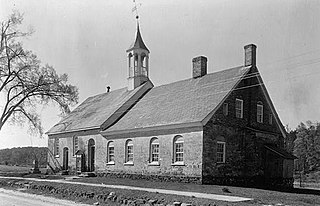
Bethabara Historic District encompasses the surviving buildings and archaeological remains of a small Moravian community, that was first settled in 1753. Located in present-day Forsyth County, North Carolina, it is now a public park of the city of Winston-Salem. It was designated National Historic Landmark in 1999.

The James Petigru Boyce Chapel is a historic church building at 1306 Hampton Street in Columbia, South Carolina. It is a Greek Revival building built in 1859. A convention met here on December 17, 1860, whose delegates voted unanimously for South Carolina to secede from the United States, leading to the American Civil War. It was designated a National Historic Landmark as First Baptist Church, the role it played at the time. The building is part of the facilities complex of the First Baptist Church, Columbia- a Southern Baptist megachurch.
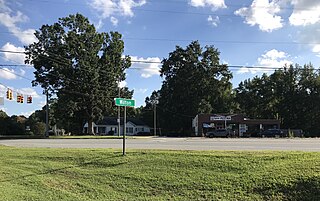
Wilton is an unincorporated community in southern Granville County, North Carolina, United States. It lies north of Grissom and is the former home of Wilton High School.

Forestville Baptist Church is a historic Baptist church located at Wake Forest in Wake County, North Carolina, a satellite town of the state capital Raleigh. Constructed in 1860, the church building is a combination of Greek Revival and Italianate style architecture. The building may be attributed to Jacob W. Holt, or his brother, Thomas J. Holt, architect with the Raleigh and Gaston Railroad.

This list includes properties and districts listed on the National Register of Historic Places in Granville County, North Carolina. Click the "Map of all coordinates" link to the right to view an online map of all properties and districts with latitude and longitude coordinates in the table below.
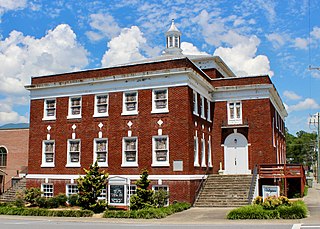
The former First Baptist Church, now the Valleytown Cultural Arts Center is a historic Baptist church building at 101 Chestnut Street in Andrews, Cherokee County, North Carolina. The Classical Revival brick structure was built in 1923 for a congregation founded in 1902; it was their second building on the site. The building was used by the congregation until c. 1987, when it was sold to a local nonprofit corporation for use as an arts center.
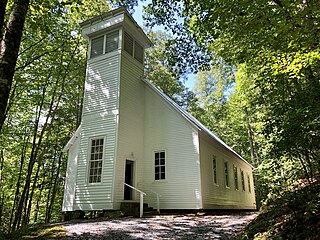
The Oconaluftee Baptist Church, also known as the Smokemont Baptist Church is a historic Baptist church in Great Smoky Mountains National Park, near Cherokee, North Carolina. It is located off United States Route 441, overlooking the Smokemont Campground of the park. It is a basically rectangular wood-frame structure, 30 feet (9.1 m) wide and 50 feet (15 m) deep. The church's tower projects from the front of this main block, and rises about 10 feet (3.0 m) above the level of the gable roof; it does not have a spire or steeple, and its uppermost section is a louvered belfry. This church building was built in 1912 for a congregation organized in 1836. The congregation's records form a valuable documentation of local history. The church remained in active use until the area was made part of the national park in 1935, and has seen occasional use since then.

Mount Shiloh Missionary Baptist Church is a historic African-American Baptist church in New Bern, Craven County, North Carolina. It was built in 1924, and is a one-story, rectangular brick church building on a raised basement in the Late Gothic Revival style. It features a tall projecting, corner tower. A two-story addition for Sunday School classrooms, a kitchen, and dining area was built in the 1970s.
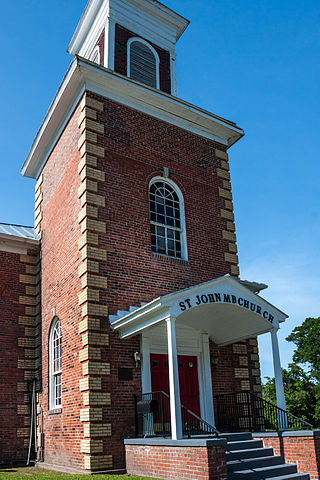
St. John's Missionary Baptist Church is a historic African-American Baptist church at 1130 Walt Bellamy Drive in New Bern, Craven County, North Carolina. It was built in 1926, and is a rectangular brick church building on a raised basement in the Classical Revival style. It features a three-stage central entrance tower. It is believed to be the oldest black Baptist congregation in New Bern.

Cape Fear Baptist Church is a historic Baptist church near Hope Mills in Grays Creek Township, Cumberland County, North Carolina.
Eastern Star Baptist Church was a historic Baptist church located at Church and Wagner Streets in Tarboro, Edgecombe County, North Carolina. The church was built about 1875, and was a one-story, Carpenter Gothic style building. It was built by a Presbyterian congregation, then moved to its final location and used by the African-American Eastern Star Baptist Church starting in 1906. It has been demolished.

Salem Methodist Church is a historic Methodist church located near Huntsboro, Granville County, North Carolina. It was likely designed by noted regional architect Jacob W. Holt and constructed by slaves in 1860–1861. It is a one-story, three-bay, heavy timber frame, church building with Greek Revival, Italianate, and Gothic Revival style design elements. Also on the property is the contributing church cemetery.
Shiloh Primitive Baptist Church is a historic rural African-American Primitive Baptist church located near Brogden, Johnston County, North Carolina. It was built about 1920, and is a vernacular one-story, gable-front, three-bay, light timber-frame building. The building was also used as a one-room school until the early 1930s. Also on the property is a contributing church cemetery with burials dating from the 1910 to 1987.

Webster Baptist Church, is an historic Southern Baptist church located at the intersection of NC 116 and SR 1340, near Webster, Jackson County, North Carolina. It was built in 1900, and is a one-story, three-bay, rectangular Vernacular Victorian style church. It has a steep gable roof, engaged three stage bell tower, and tall round-headed windows. The church retains its original furniture built and donated by local master cabinetmaker Joseph Warrenton Cowan (1834-1917) and his son, Lawrence Cowan.

Halifax Historic District is a national historic district located at Halifax, Halifax County, North Carolina, US that was listed on the National Register of Historic Places in 1970. It includes several buildings that are individually listed on the National Register. Halifax was the site of the signing of the Halifax Resolves on April 12, 1776, a set of resolutions of the North Carolina Provincial Congress which led to the United States Declaration of Independence gaining the support of North Carolina's delegates to the Second Continental Congress in that year.

First Baptist Church is a historic Baptist church located at Asheville, Buncombe County, North Carolina. It was designed by architect Douglas Ellington and built in 1925–1927. It is a four-story, domed, polygonal brick building with Art Deco design influences. The front facade features a colossal hectastyle portico.

Granville County Courthouse is a historic courthouse building located at Oxford, Granville County, North Carolina. It was built in 1838, and is a two-story, H-shaped, Greek Revival style brick building. It has a three-bay central pavilion and a polygonal cupola with a domed room.

Oxford Historic District is a national historic district located at Oxford, Granville County, North Carolina. The district encompasses 201 contributing buildings, 1 contributing site, and 2 contributing objects in the central business district and surrounding residential sections of Oxford. It includes buildings dating from the early-19th century through the 1930s and notable examples of Greek Revival and Late Victorian style architecture. Located in the district is the separately listed Granville County Courthouse (1838-1840). Other notable buildings include the Bryant-Kingsbury House, Taylor-McClanahan-Smith House (1820s), former Granville County Jail, Oxford Women's Club, Titus Grandy House (1850s), Oxford Presbyterian Church, St. John's College, Lyon-Winston Building (1911), Herndon Block Number 2, Hunt Building, L. H. Currin-American Tobacco Company (1860s), and St. Stephens Episcopal Church (1902).


















